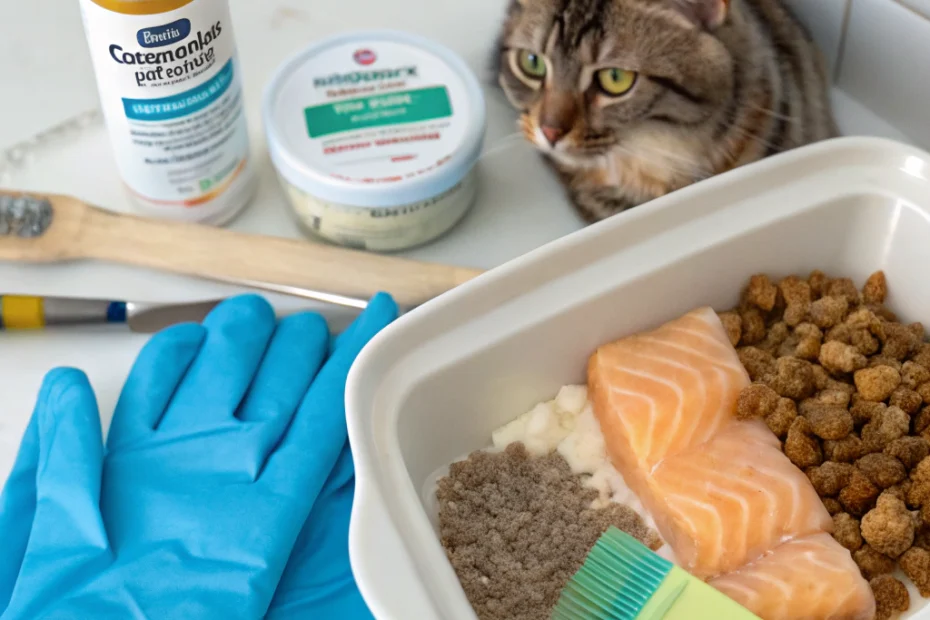At a Glance
- Ringworm is a contagious fungal skin infection (not a worm).
- Typical signs: circular hair loss, scaly or crusty skin, itch.
- Spreads to other pets and people; early diagnosis and hygiene are key.
- Treatment combines antifungals and thorough environmental cleaning.
Common Signs
- Round or irregular patches of hair loss with flaky skin.
- Brittle or broken hairs; dull coat.
- Mild to moderate itch; some cats may be non-itchy.
- Lesions on face, ears, paws, tail; nails can be affected.
How to Choose a Treatment Plan
Start with your veterinarian for a confirmed diagnosis (e.g., fungal culture, PCR, or Wood’s lamp). Plans commonly include:
- Topical therapy: Vet-approved antifungal shampoos, rinses, creams, or sprays.
- Oral antifungals: Prescribed when infection is widespread or persistent.
- Environmental control: Cleaning to reduce spores and prevent reinfection.
Note: Use only cat-safe products. “Over-the-counter” or household antifungals are not substitutes for veterinary care.
Safety & Setup
- Wear disposable gloves when handling lesions or applying treatments.
- Keep the cat in an easy-to-clean room (hard floors, minimal fabric) during active treatment.
- Prevent contact with high-risk people (young children, elderly, immunocompromised) until cleared.
- Give medications exactly as prescribed; do not stop early even if lesions look better.
Cleaning Tips (Environmental Decontamination)
- Laundry: Wash bedding, blankets, soft toys, and washable covers in hot water; dry on high.
- Vacuum: Vacuum floors, rugs, and upholstery daily at first; empty canister or replace bags promptly.
- Hard surfaces: Wipe with a pet-safe disinfectant per label contact time.
- Clutter control: Reduce fabric items and hideouts that can trap spores until recovery.
Core Pillars of Management
- Diagnosis: Confirm the cause before treating.
- Consistent therapy: Follow the full topical/oral plan; recheck cultures as advised.
- Hygiene: Systematic cleaning to break the reinfection cycle.
- Monitoring: Track lesion size, new spots, coat quality, and any drug side effects.
Placement & Environment Tips
- Choose a bright, well-ventilated room that’s easy to sanitize.
- Provide scratching posts and washable beds that can be laundered frequently.
- Trim long hair (if recommended by your vet) to improve topical contact—do not shave lesions without guidance.
Litter Box Considerations
- Scoop daily; fully change litter at least weekly during treatment.
- Use a box with smooth, non-porous surfaces for easier disinfection.
- Clean the box and surrounding floor regularly with a pet-safe disinfectant.
Comparison with Alternatives
- Topical only: Works for mild, localized disease with excellent owner compliance; slower for multi-site infections.
- Oral + topical (combo): Standard for moderate to severe or multi-pet households; usually more effective.
- “Natural” remedies: Often inadequate and sometimes unsafe for cats; use only vet-approved products.
FAQs
Is ringworm contagious to people?
Yes. It’s zoonotic. Use gloves, wash hands, and limit close contact until your vet confirms clearance.
How long does treatment take?
Typically several weeks to a few months. Many vets require two negative cultures before declaring cure.
Can other pets catch it?
Yes. Check and, if needed, treat exposed pets. Keep separate bedding and grooming tools.
When should I see improvement?
Lesions usually stop spreading within 1–2 weeks of proper therapy; hair regrowth follows over weeks.
What if lesions return?
Relapses often mean incomplete environmental cleaning or shortened therapy. Revisit your vet for culture and plan adjustment.
Bottom Line
With a confirmed diagnosis, consistent antifungal treatment, and diligent cleaning, most cats recover well from ringworm. Team up with your veterinarian and stick to the plan until full clearance.
Medical disclaimer: This article is educational and not a substitute for veterinary care. Always consult your veterinarian for diagnosis and treatment tailored to your cat.
